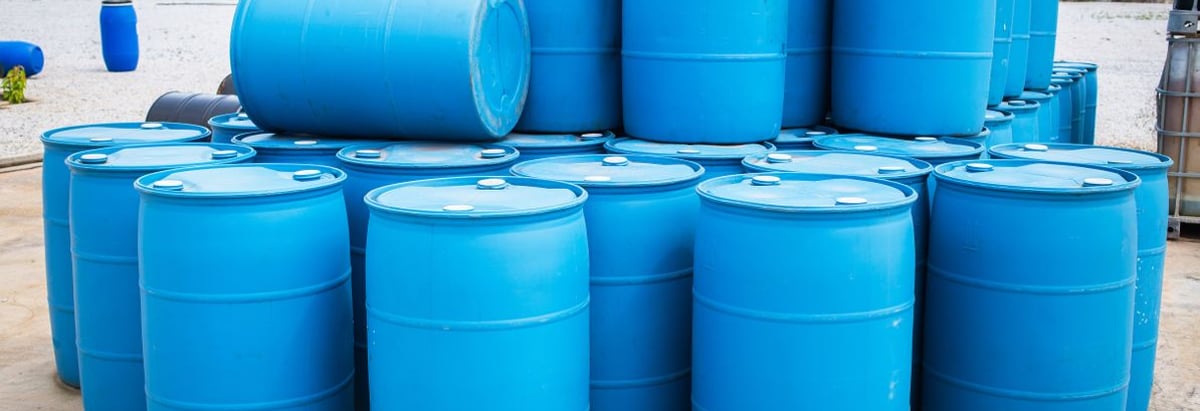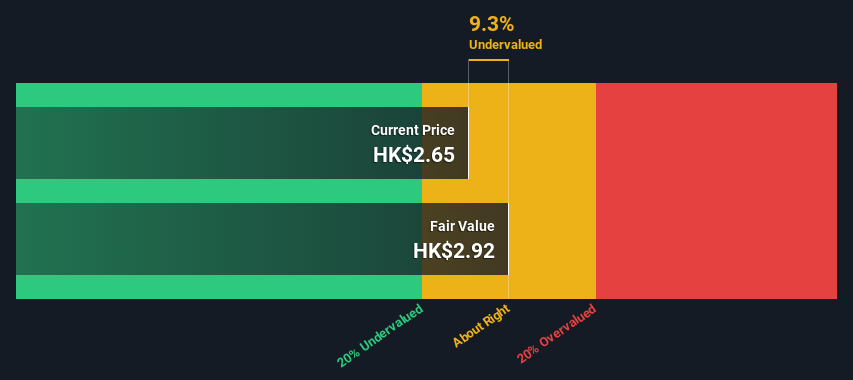Estimating The Intrinsic Value Of Southeast Asia Properties & Finance Limited (HKG:252)

Key Insights
- Using the 2 Stage Free Cash Flow to Equity, Southeast Asia Properties & Finance fair value estimate is HK$2.92
- With HK$2.65 share price, Southeast Asia Properties & Finance appears to be trading close to its estimated fair value
- Peers of Southeast Asia Properties & Finance are currently trading on average at a 589% premium
Today we'll do a simple run through of a valuation method used to estimate the attractiveness of Southeast Asia Properties & Finance Limited (HKG:252) as an investment opportunity by taking the forecast future cash flows of the company and discounting them back to today's value. This will be done using the Discounted Cash Flow (DCF) model. Don't get put off by the jargon, the math behind it is actually quite straightforward.
We would caution that there are many ways of valuing a company and, like the DCF, each technique has advantages and disadvantages in certain scenarios. Anyone interested in learning a bit more about intrinsic value should have a read of the Simply Wall St analysis model.
Check out our latest analysis for Southeast Asia Properties & Finance
Crunching The Numbers
We're using the 2-stage growth model, which simply means we take in account two stages of company's growth. In the initial period the company may have a higher growth rate and the second stage is usually assumed to have a stable growth rate. To begin with, we have to get estimates of the next ten years of cash flows. Seeing as no analyst estimates of free cash flow are available to us, we have extrapolate the previous free cash flow (FCF) from the company's last reported value. We assume companies with shrinking free cash flow will slow their rate of shrinkage, and that companies with growing free cash flow will see their growth rate slow, over this period. We do this to reflect that growth tends to slow more in the early years than it does in later years.
Generally we assume that a dollar today is more valuable than a dollar in the future, so we need to discount the sum of these future cash flows to arrive at a present value estimate:
10-year free cash flow (FCF) estimate
| 2024 | 2025 | 2026 | 2027 | 2028 | 2029 | 2030 | 2031 | 2032 | 2033 | |
| Levered FCF (HK$, Millions) | HK$36.9m | HK$35.8m | HK$35.3m | HK$35.2m | HK$35.4m | HK$35.7m | HK$36.1m | HK$36.6m | HK$37.2m | HK$37.9m |
| Growth Rate Estimate Source | Est @ -4.89% | Est @ -2.81% | Est @ -1.36% | Est @ -0.34% | Est @ 0.38% | Est @ 0.88% | Est @ 1.22% | Est @ 1.47% | Est @ 1.64% | Est @ 1.76% |
| Present Value (HK$, Millions) Discounted @ 6.9% | HK$34.5 | HK$31.3 | HK$28.9 | HK$26.9 | HK$25.3 | HK$23.9 | HK$22.6 | HK$21.4 | HK$20.4 | HK$19.4 |
("Est" = FCF growth rate estimated by Simply Wall St)
Present Value of 10-year Cash Flow (PVCF) = HK$255m
The second stage is also known as Terminal Value, this is the business's cash flow after the first stage. For a number of reasons a very conservative growth rate is used that cannot exceed that of a country's GDP growth. In this case we have used the 5-year average of the 10-year government bond yield (2.0%) to estimate future growth. In the same way as with the 10-year 'growth' period, we discount future cash flows to today's value, using a cost of equity of 6.9%.
Terminal Value (TV)= FCF2033 × (1 + g) ÷ (r – g) = HK$38m× (1 + 2.0%) ÷ (6.9%– 2.0%) = HK$790m
Present Value of Terminal Value (PVTV)= TV / (1 + r)10= HK$790m÷ ( 1 + 6.9%)10= HK$404m
The total value is the sum of cash flows for the next ten years plus the discounted terminal value, which results in the Total Equity Value, which in this case is HK$658m. The last step is to then divide the equity value by the number of shares outstanding. Compared to the current share price of HK$2.7, the company appears about fair value at a 9.3% discount to where the stock price trades currently. The assumptions in any calculation have a big impact on the valuation, so it is better to view this as a rough estimate, not precise down to the last cent.

The Assumptions
The calculation above is very dependent on two assumptions. The first is the discount rate and the other is the cash flows. If you don't agree with these result, have a go at the calculation yourself and play with the assumptions. The DCF also does not consider the possible cyclicality of an industry, or a company's future capital requirements, so it does not give a full picture of a company's potential performance. Given that we are looking at Southeast Asia Properties & Finance as potential shareholders, the cost of equity is used as the discount rate, rather than the cost of capital (or weighted average cost of capital, WACC) which accounts for debt. In this calculation we've used 6.9%, which is based on a levered beta of 0.893. Beta is a measure of a stock's volatility, compared to the market as a whole. We get our beta from the industry average beta of globally comparable companies, with an imposed limit between 0.8 and 2.0, which is a reasonable range for a stable business.
SWOT Analysis for Southeast Asia Properties & Finance
- Debt is not viewed as a risk.
- Dividend is low compared to the top 25% of dividend payers in the Packaging market.
- Current share price is below our estimate of fair value.
- Lack of analyst coverage makes it difficult to determine 252's earnings prospects.
- No apparent threats visible for 252.
Next Steps:
Valuation is only one side of the coin in terms of building your investment thesis, and it shouldn't be the only metric you look at when researching a company. The DCF model is not a perfect stock valuation tool. Instead the best use for a DCF model is to test certain assumptions and theories to see if they would lead to the company being undervalued or overvalued. For instance, if the terminal value growth rate is adjusted slightly, it can dramatically alter the overall result. For Southeast Asia Properties & Finance, there are three essential items you should consider:
- Risks: You should be aware of the 2 warning signs for Southeast Asia Properties & Finance we've uncovered before considering an investment in the company.
- Management:Have insiders been ramping up their shares to take advantage of the market's sentiment for 252's future outlook? Check out our management and board analysis with insights on CEO compensation and governance factors.
- Other Solid Businesses: Low debt, high returns on equity and good past performance are fundamental to a strong business. Why not explore our interactive list of stocks with solid business fundamentals to see if there are other companies you may not have considered!
PS. Simply Wall St updates its DCF calculation for every Hong Kong stock every day, so if you want to find the intrinsic value of any other stock just search here.
If you're looking to trade Southeast Asia Properties & Finance, open an account with the lowest-cost platform trusted by professionals, Interactive Brokers.
With clients in over 200 countries and territories, and access to 160 markets, IBKR lets you trade stocks, options, futures, forex, bonds and funds from a single integrated account.
Enjoy no hidden fees, no account minimums, and FX conversion rates as low as 0.03%, far better than what most brokers offer.
Sponsored ContentNew: Manage All Your Stock Portfolios in One Place
We've created the ultimate portfolio companion for stock investors, and it's free.
• Connect an unlimited number of Portfolios and see your total in one currency
• Be alerted to new Warning Signs or Risks via email or mobile
• Track the Fair Value of your stocks
Have feedback on this article? Concerned about the content? Get in touch with us directly. Alternatively, email editorial-team (at) simplywallst.com.
This article by Simply Wall St is general in nature. We provide commentary based on historical data and analyst forecasts only using an unbiased methodology and our articles are not intended to be financial advice. It does not constitute a recommendation to buy or sell any stock, and does not take account of your objectives, or your financial situation. We aim to bring you long-term focused analysis driven by fundamental data. Note that our analysis may not factor in the latest price-sensitive company announcements or qualitative material. Simply Wall St has no position in any stocks mentioned.
About SEHK:252
Southeast Asia Properties & Finance
An investment holding company, manufactures and distributes plastic packaging materials in Hong Kong, the People's Republic of China, Japan, Oceania, North America, and Europe.
Mediocre balance sheet low.
Market Insights
Community Narratives




